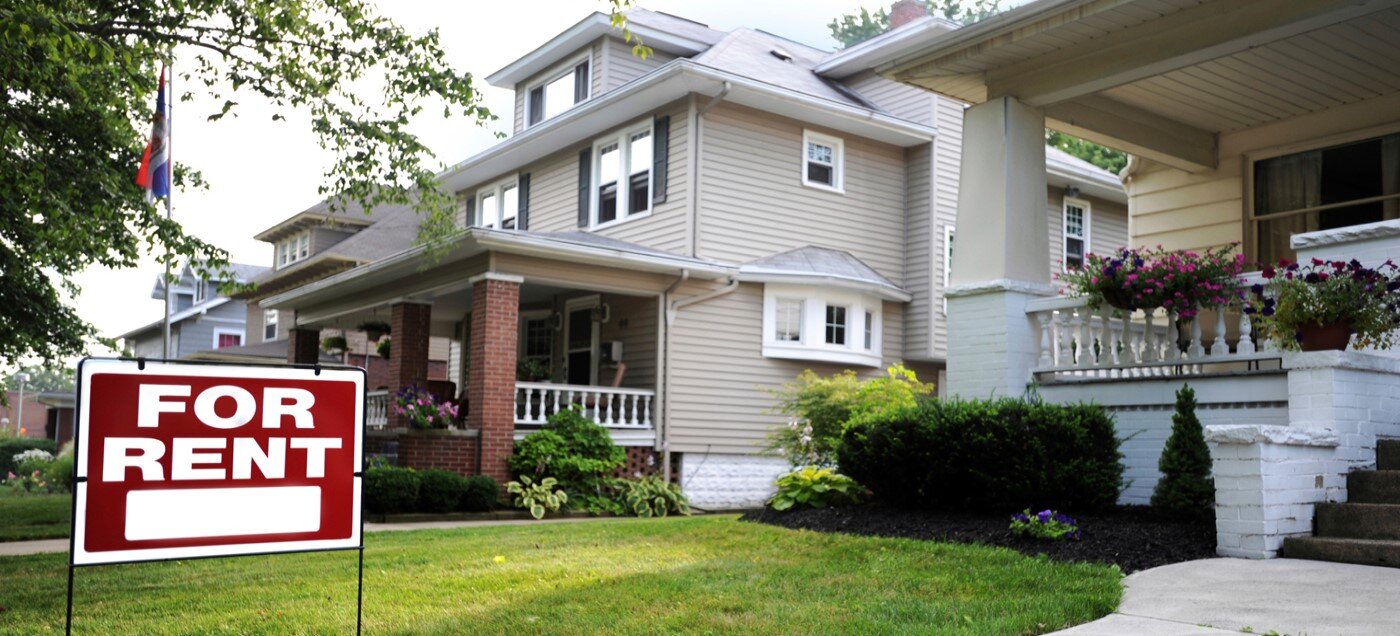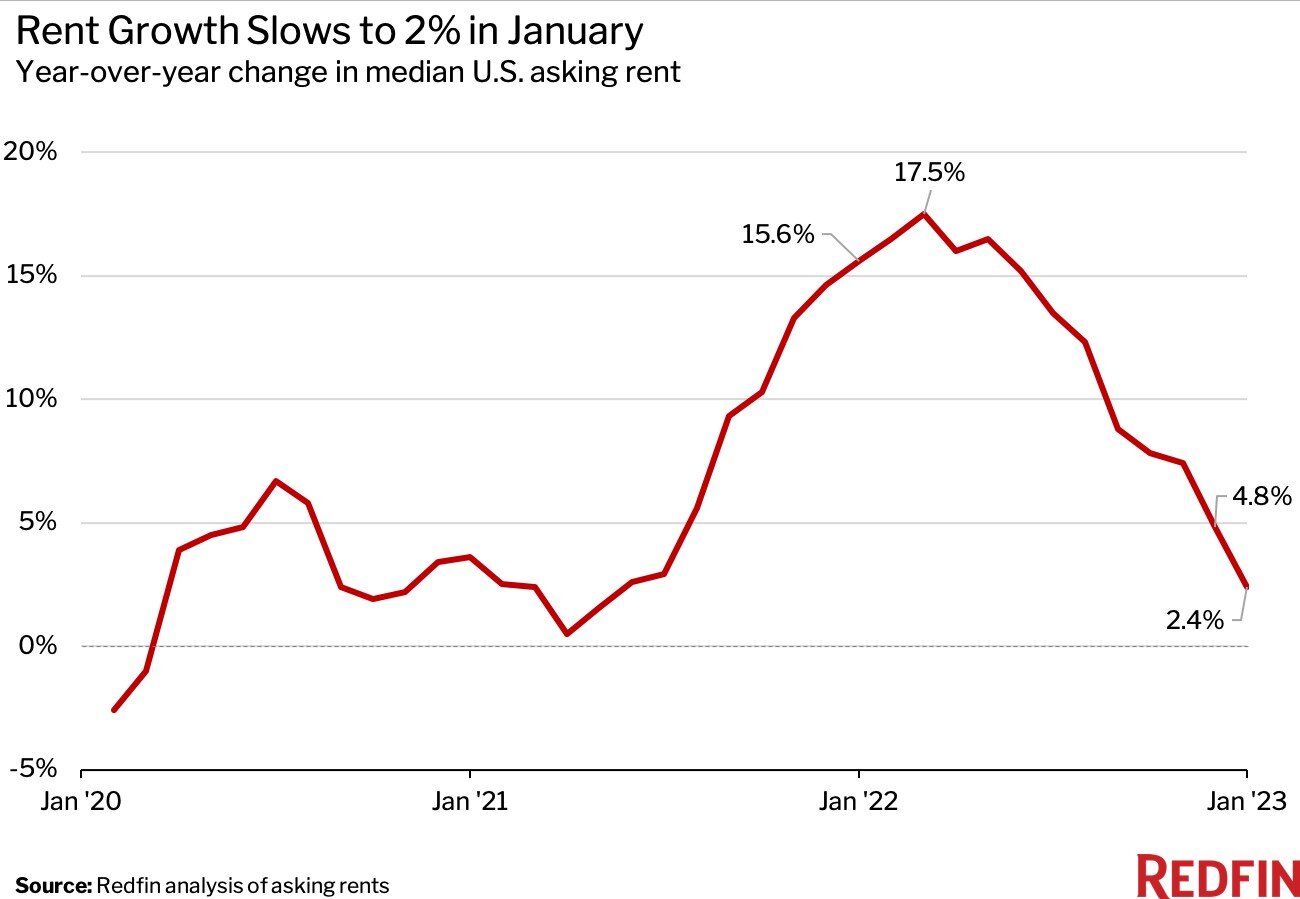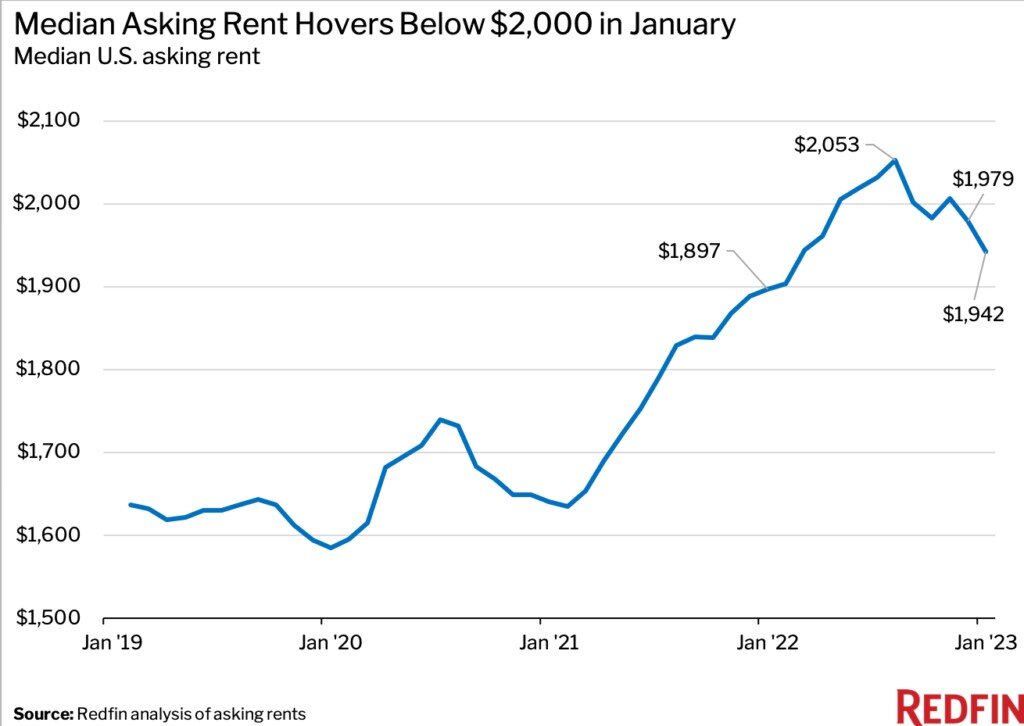Residential Real Estate News

Residential Asking Rents in U.S. Post Smallest Increase in 20 Months in January
Residential News » Seattle Edition | By WPJ Staff | February 15, 2023 9:02 AM ET
According to a new report from Redfin, the median U.S. residential rental asking rent rose 2.4% year over year to $1,942 in January 2023 -- the smallest increase since May 2021 and the lowest level in nearly a year. That's roughly one-sixth the pace of January 2022, when rents were up 15.6% from a year earlier.
January marked the eighth straight month in which annual rent growth slowed. Rents fell 1.9% from a month earlier and were down 5.4% from the August peak of $2,053.
Rent growth is cooling because of slowing demand and growing supply. Demand has slowed due to still-high costs (rents remain 22.5% higher than they were in January 2020), inflation, widespread economic uncertainty and slowing household formation. Rental supply has grown due to an influx of construction in recent years, as well as a recent increase in the number of people opting to rent out their homes instead of sell.

"We're watching closely to see whether rents start falling year over year. That would be a welcome relief for renters because it hasn't happened since the onset of the pandemic," said Redfin Chief Economist Daryl Fairweather. "If rents do start falling on a year-over-year basis, it will mean that renters have more room to negotiate. It may also prompt more landlords to sell their properties because they're no longer getting a good return on their investment."
The nationwide rental vacancy rate stopped falling at the end of 2022 and is expected to grow in the coming months as more rentals hit the market, an indicator that rental prices may continue to slow, Fairweather added.
Rent increases were a significant driver of last year's high inflation, and now, slowing rent growth is expected to help cool inflation in the coming months. In fact, young adults signing new leases now have lower personal inflation rates than the overall U.S. population for the first time in two years, thanks mainly to slowing rent growth.
Rents Declined in 11 Major U.S. Metro Areas
In Phoenix, the median asking rent declined 6.7% year over year in January, the largest drop among the 50 most populous U.S. metropolitan areas. Next came Oklahoma City (-6.3%), New Orleans (-5.2%), Minneapolis (-5.1%) and Houston (-4.9%).
1. Phoenix, AZ (-6.7%)
2. Oklahoma City, OK (-6.3%)
3. New Orleans, LA (-5.2%)
4. Minneapolis, MN (-5.1%)
5. Houston, TX (-4.9%)
6. Baltimore, MD (-4.6%)
7. Birmingham, AL (-3.4%)
8. Chicago, IL (-3.0%)
9. Virginia Beach, VA (-1.8%)
10. Seattle, WA (-1.0%)
11. Austin, TX (-0.4%)
Raleigh Saw the Largest Rent Increase
1. Raleigh, NC (22.5%)
2. Cleveland, OH (17.5%)
3. Indianapolis, IN (14.9%)
4. Charlotte, NC (14.2%)
5. Nashville, TN (9.8%)
6. Kansas City, MO (8.8%)
7. Louisville, KY (8.2%)
8. Milwaukee, WI (7.7%)
9. Jacksonville, FL (7.5%)
10. Providence RI (7.3%)
Sign Up Free | The WPJ Weekly Newsletter
Relevant real estate news.
Actionable market intelligence.
Right to your inbox every week.
Real Estate Listings Showcase
Related News Stories
Residential Real Estate Headlines
- Las Vegas Area Home Prices Uptick 4.3 Percent Annually in March
- Single-Family Rent Growth in U.S. Trends Upward in 2025
- U.S. Mortgage Rates Tick Down Post Trump Tariffs Commencement
- President Trump's 'Liberation Day' Tariffs Potential Impact on the U.S. Housing and Mortgage Markets
- Baby Boomers Biggest Cohort of U.S. Home Buyers in 2025 as Millennials Decline
- U.S. Monthly Housing Payments Hit Record High in 2025
- U.S. Pending Home Sales Uptick in February
- Global Prime Residential Rent Slowdown Continued in Late 2024
- Ireland Home Price Inflation Hits 8 Year High in Early 2025
- Existing Home Sales in America Uptick in February
- Great Miami Area Residential Sales Decline 15 Percent Annually in February
- Mortgage Rates Uptick in Mid-March, Ending 9-Week Decline in U.S.
- World Property Ventures Builds the Future of Real Estate with New Funding Round
- U.S. Builder Sentiment Declines Amid Economic Uncertainty and Rising Costs
- Black Homeownership Rates in U.S. Enjoy Largest Annual Increase of All Racial Groups
- Wealthy Renters Are Taking Over More of the U.S. Rental Market
- If U.S. Congress Does Not Extend NFIP Soon, Thousands of Daily Home Closings Impacted
- U.S. Mortgage Applications Spike 11 Percent in Early March
- Greater Palm Beach Area Residential Sales Rise in Early 2025
- New Apartments in U.S. Are Leasing at Slowest Pace on Record
- U.S. Mortgage Rates Drop to 4 Month Low in March
- Overall U.S. Mortgage Delinquency Rates Dip in December
- New Tariffs on Canada, Mexico to Impact U.S. Homebuilder Input Costs
- Monaco's Property Market: A Tale of Two Cities
- U.S. Home Purchase Cancellations Surge, 1 in 7 Sales Getting Canceled
- U.S. Pending Home Sales Hit Historic Low in Early 2025
- Greater Miami Area Residential Sales Dip in January
- Governor DeSantis Supports Ending Property Taxes in Florida
- WPV Aims to Become the Berkshire Hathaway of Real Estate Tech
- U.S. Home Sales Slump Continues in January
- Average Americans Spend 38 Percent of Monthly Income on Mortgage Payments
- Switzerland's Safe-Haven Appeal Grows with World's Wealthy Homebuyers
- U.S. Builder Confidence Rapidly Declines in February
- Las Vegas Home Sales Rise 6.7 Percent Annually in January, Condo Sales Dip
- Homebuyer Demand in America Drops to 5-Year Low in Early 2025
- Ownership More Affordable Than Renting in Most U.S. Markets
- The World's First Global Listings Service Launches, Called a GLS
- Home Prices Continue to Rise in 89 Percent of U.S. Metros in Late 2024
- Global Luxury Residential Prices Showed Gradual Improvement in Late 2024
- U.S. Construction Hiring Rate Drops to Lowest Levels in 5 Years







